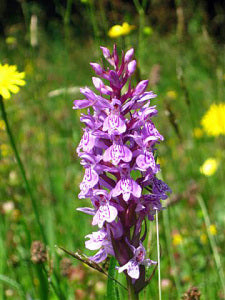Local seed for meadows
Share
I've borrowed an acre or so of land to turn into a wildflower meadow in the corner of one of Archie's potato fields next to Sparkford, on the A303. Although I've been working on some areas at home over the last couple of years I thought it was time to do something much more public to promote the idea and - hopefully - show how it can be done. And we do need to do something. Although we are waking up to the problem, the catastrophic loss of ancient meadows - an estimated 98% since 1945 - has had an inestimable impact. Unimproved grassland is one of the most important of our native habitats, and its disappearance seems to be a major factor in recent declines and extinctions of a number of species. We can't replace ancient meadows overnight, but we can make a difference by creating new ones and - wow! - they're beautiful. I'll be banging on a good deal about meadows, but for the time being you can find out more about Archie's site and other projects on our website.
Today I wanted to write about the need for using the right seed mixes for them. I've been slightly taken aback by people's ideas about what constitutes a "traditional" meadow. Folk are planting initially beautiful annual flowers rather than perennial mixes WITH grasses, and managing them poorly so they disappear. There are now some gorgeous North American annual mixes available too which are understandably popular, but not what's required. Many packet "native" seed mixes also seem to include non-native plants, which is unhelpful. Not only that, but work by Scotia Seeds suggests that some commercially available mixes have germination rates as low as... zero.
I'm trying to follow some guidelines in our work and in what we're promoting on the website:
Use only native seed. Native animals need native plants, and no-one needs invasive foreign species or hybrids.
Use only high quality seed. A low germination rate means all your work will be wasted.
Plant as diverse a mix as possible. The more species of flora you have, the more beautiful the meadow will look and the more species of fauna you will support.
Plan and manage the sward properly. Work out what kind of conditions you have and find an appropriate mix, which will then need an annual regime.
 Lastly, try to use local seed. It seems to me that it will not only do better and include possibly rare species, but also be more relevant to local fauna. We are trying to encourage unimproved meadow owners to produce seed (do you know anyone who might be interested ?), but it is a difficult, commercially hazardous and highly specialized business. There is currently only a handful of commercial suppliers who produce the really good quality and regionally appropriate mixes we sell ourselves. We will be using some seed from a local meadow in our new project, which I'm very excited about and which we'll be selling on the website. This mix includes the Corky-fruited Water-dropwort (!), which I gather is typical of this area, and in a couple of years time we will be sowing some lovely orchids, including the one pictured, I'm told a hybrid Common Spotted / Marsh orchid.
Lastly, try to use local seed. It seems to me that it will not only do better and include possibly rare species, but also be more relevant to local fauna. We are trying to encourage unimproved meadow owners to produce seed (do you know anyone who might be interested ?), but it is a difficult, commercially hazardous and highly specialized business. There is currently only a handful of commercial suppliers who produce the really good quality and regionally appropriate mixes we sell ourselves. We will be using some seed from a local meadow in our new project, which I'm very excited about and which we'll be selling on the website. This mix includes the Corky-fruited Water-dropwort (!), which I gather is typical of this area, and in a couple of years time we will be sowing some lovely orchids, including the one pictured, I'm told a hybrid Common Spotted / Marsh orchid.


